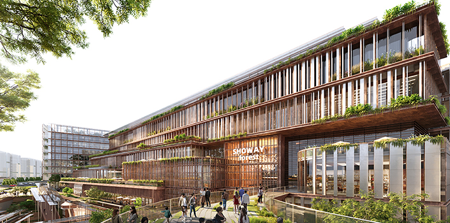

Luenmei South Hongqiao Mixed-use Project
Benoy
Luenmei South Hongqiao Mixed-use Project is strategically located on the west side of the National Exhibition and Convention Center (Shanghai), serving as a pivotal support services hub for the future NECC exhibition cluster industry. The project design aims to incorporate comprehensive functions and complex development models to meet these demands. 2.Program: Based on a thorough urban design analysis, the project integrates and organizes urban functional zones, aligning commercial axis, landscape resources, and transportation conditions. It establishes relatively independent office, hotel, and centralized commercial functions, to meet business needs while connecting with the surrounding urban functions. The design optimizes attributes and enhances urban public and community spaces through an open layout that connects the exhibition with the surrounding pedestrian flow. 3.Wilderness in the city: How can we harness the concept of harmony between man and nature to restore traditional Chinese demand for integrating with nature in daily life, while also critiquing the large-scale, pervasive commercialization that dominates modern urban development? In response to the challenge of unrealistic large-scale greenery, we propose a new design concept: the Hongye-Red Field. This concept uses the natural tones of bare land, soft building forms, and tiered setbacks to create an urban mountain and wilderness image. The aim is to provide a soulful experience of being in the mountains and wilderness within a busy urban environment during exhibition, work, and daily life. 4.24-hour Open Neighborhood In a high-density, homogenized urban space, the project introduces a pedestrian-friendly public axis by opening up the boundaries. This creates a pedestrian-friendly environment in an area dominated by vehicular traffic, allowing people to traverse the site's open blocks freely and safely. 5. Pedestrian-friendly sky corridor system The design features a sky public corridor based on the public axis, enabling safe pedestrian crossing and connecting the National Convention and Exhibition Center with surrounding sites. This maximizes the extension of public realm. 6. Urban public green field The project incorporates retreating steps in its architectural form, allowing ecological greenery to climb upwards along the public walkway to the higher parts of the building. In high-density urban spaces, this design creates the character of a natural wild valley within the city. 7. Eco-first façade strategy The building façade design introduces natural light and maximizes passive energy-saving operation through colourful sunshade strips, maintaining optimal internal views. 8. Stitching of street texture Focusing on internal public axis, the design uses a unique L-shaped volume around the building exterior. This creates an urban image with a prominent corner fit, maximizing the stitching of street textures within the urban space and facilitates connectivity across municipal areas. 9. Visual corridor and breathing space in high density development Through the public axis and a sky corridor, the project offers the public a spacious visual corridor and a freely accessible public area. Emphasizing user experience, the project stimulates community aggregation and innovation within the industrial community to gather and innovate, thereby maximizing urban value.